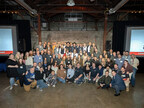NEW YORK, May 31, 2024 /PRNewswire/ — The global textile industry waste management market size is estimated to grow by USD 2.32 billion from 2024-2028, according to Technavio. The market is estimated to grow at a CAGR of 11.57% during the forecast period.
For more insights on the forecast market size and historic data (2018 – 2022) – Download Free sample report in minutes
Forecast period
2024-2028
Base Year
2023
Historic Data
2018 – 2022
Segment Covered
Application (Wastewater treatment equipment and Water purifier), Service Type (Landfill, Open dumping, Incineration, Recycling, and Composting and anaerobic digestion), and Geography (APAC, North America, Europe, Middle East and Africa, and South America)
Region Covered
APAC, North America, Europe, Middle East and Africa, and South America
Key companies profiled
Aditya Birla Management Corp. Pvt. Ltd., American Waste and Textile LLC, BLS Ecotech Ltd., Boer Group, Evrnu Inc., FABSCRAP, Fibershed, Hyosung TNC Corp., Infinited Fiber Co., Lenzing AG, Pistoni Srl, Pure Waste Textiles Oy, Re NewCell AB, Recover Textile Systems S.L, Remondis SE and Co. KG, SAAHAS WASTE MANAGEMENT Pvt. Ltd., TEXAID Textilverwertungs AG, Unifi Inc., Veolia Environnement SA, and Worn Again Technologies
Key Market Trends Fueling Growth
The textile industry waste management market is experiencing significant growth due to the integration of advanced technologies like artificial intelligence (AI) and the Internet of Things (IoT). These innovations enhance waste management and decrease textile waste by monitoring the entire supply chain. AI-powered sorting machines revolutionize textile recycling, while IoT sensors track raw material usage, water, and energy consumption for sustainable production.
IoT-powered distribution systems optimize logistics, and smart tags enable real-time product monitoring, preventing overproduction and minimizing wastage. Additionally, AI-powered predictive maintenance technology ensures machinery is well-maintained, reducing equipment breakdown and promoting more sustainable practices. Overall, these factors are driving the adoption of AI and IoT in textile waste management, fueling market growth.
The textile industry generates large amounts of waste, including carbon dioxide, water, and textile scraps. Carbon dioxide emissions result from energy consumption during manufacturing processes. Water waste arises from dyeing and finishing processes. Textile scraps are generated during cutting and sewing. Industry trends focus on reducing waste through circular economy principles. For instance, recycling textile scraps into new materials. Additionally, energy-efficient technologies and renewable energy sources are being adopted to decrease carbon emissions.
Chemicals, such as dyes and finishing agents, are used extensively in textile production. Recycling and reusing these chemicals can help minimize waste. Furthermore, the use of biodegradable and eco-friendly alternatives is gaining popularity. Online platforms and marketplaces facilitate the buying and selling of recycled textiles, reducing the need for new production and minimizing waste. Overall, the textile industry is making strides towards more sustainable practices and waste reduction.
Market Challenges
The textile industry generates vast amounts of waste, primarily due to the lack of adequate disposal facilities. This issue significantly impacts the environment and the industry’s reputation. For instance, denim jeans production necessitates substantial water, chemicals, and energy usage, resulting in considerable waste. Unfortunately, this waste often ends up in landfills, polluting the environment and posing health risks.The absence of proper waste management also deters consumers, who are increasingly conscious of the environmental impact of clothing production. Companies that neglect waste management may face customer loss and legal action, hindering the textile industry’s growth during the forecast period.The Textile Industry generates large amounts of waste, including packaging, textile scraps, and dyes. Effective waste management is crucial for reducing environmental impact and improving sustainability. However, challenges exist in implementing waste reduction strategies. These include high production volumes, complex supply chains, and varying regulations across regions.Additionally, the cost of waste disposal and the lack of standardized recycling processes can hinder progress. To address these challenges, companies must invest in innovative technologies and collaborate with industry partners to develop more efficient and eco-friendly production methods. This will not only benefit the environment but also improve the industry’s reputation and competitiveness.
Research report provides comprehensive data on impact of trend, driver and challenges – Download Free sample report in minutes
Segment Overview
Application 1.1 Wastewater treatment equipment1.2 Water purifierService Type2.1 Landfill2.2 Open dumping2.3 Incineration2.4 Recycling2.5 Composting and anaerobic digestionGeography 3.1 APAC3.2 North America3.3 Europe3.4 Middle East and Africa3.5 South America
1.1 Wastewater treatment equipment- The textile industry generates large amounts of wastewater due to the use of chemicals and dyes in production processes. Effective waste management is crucial to address environmental concerns. Sedimentation tanks remove solid wastes, biological treatment systems use microorganisms to break down organic pollutants, and chemical treatment equipment adds chemicals to clump particles for removal. Advanced oxidation processes and membrane filtration systems are also used for persistent pollutants and high-quality effluents, respectively. These equipment types are driving the growth of the textile industry waste management market.
For more information on market segmentation with geographical analysis including forecast (2024-2028) and historic data (2018 – 2022) – Download a Sample Report
Research Analysis
The Textile Industry generates a significant amount of waste, primarily in the form of hazardous plastic and polyester materials. Open dumping and incineration methods have been historically used for disposal, leading to detrimental environmental impact. However, the shift towards sustainability and eco-friendliness has brought recycling into the limelight. Residential, commercial, and industrial sectors all contribute to textile waste.
Textile packaging processes, including nanofiltration, also generate wastewater that requires proper management. Natural fibers like cotton, silk, wool, and linen, as well as yarn medleys and polyesters, can all be recycled through chemical textile recycling processes. Sustainability remains a key focus area, with reuse and nanofiltration processes gaining popularity to mitigate the environmental impact of textile waste.
Market Research Overview
The Textile Industry generates substantial waste throughout the production process, from fiber extraction to finished garments. Waste management in this sector is crucial to mitigate environmental impacts and promote sustainability. Major types of textile industry waste include water pollutants, solid waste, and chemical effluents. Innovative solutions such as recycling, reusing, and upcycling are being adopted to transform waste into valuable resources.
Technologies like membrane filtration, reverse osmosis, and bioremediation are used to treat and purify wastewater. Mechanical and biological methods are employed for solid waste management. The use of renewable energy sources and closed-loop production systems further enhances waste reduction and management in the textile industry.
Table of Contents:
1 Executive Summary
2 Market Landscape
3 Market Sizing
4 Historic Market Size
5 Five Forces Analysis
6 Market Segmentation
ApplicationWastewater Treatment EquipmentWater PurifierService TypeLandfillOpen DumpingIncinerationRecyclingComposting And Anaerobic DigestionGeographyAPACNorth AmericaEuropeMiddle East And AfricaSouth America
7 Customer Landscape
8 Geographic Landscape
9 Drivers, Challenges, and Trends
10 Company Landscape
11 Company Analysis
12 Appendix
About Technavio
Technavio is a leading global technology research and advisory company. Their research and analysis focuses on emerging market trends and provides actionable insights to help businesses identify market opportunities and develop effective strategies to optimize their market positions.
With over 500 specialized analysts, Technavio’s report library consists of more than 17,000 reports and counting, covering 800 technologies, spanning across 50 countries. Their client base consists of enterprises of all sizes, including more than 100 Fortune 500 companies. This growing client base relies on Technavio’s comprehensive coverage, extensive research, and actionable market insights to identify opportunities in existing and potential markets and assess their competitive positions within changing market scenarios.
Contacts
Technavio Research
Jesse Maida
Media & Marketing Executive
US: +1 844 364 1100
UK: +44 203 893 3200
Email: media@technavio.com
Website: www.technavio.com/
View original content to download multimedia:https://www.prnewswire.com/news-releases/textile-industry-waste-management-market-size-is-set-to-grow-by-usd-2-32-billion-from-2024-2028–increasing-awareness-about-sustainability-and-environmental-protection-to-boost-the-market-growth-technavio-302160213.html
SOURCE Technavio


 Near Videos5 days ago
Near Videos5 days ago
 Technology4 days ago
Technology4 days ago
 Technology5 days ago
Technology5 days ago
 Technology4 days ago
Technology4 days ago









